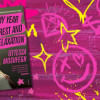Between falling and failing

TW: Suicide
If you look closely at the small claustrophobic spaces between falling and failing, you can always find a woman. But as a society that is quick to consume tragic stories of women and their demise, we often forget to ask—who put them there?
Historically, universal representations of womanhood have always been filled with suffering. But often, it isn't until that suffering culminates in a form that is visually evocative and hauntingly painful, that it becomes significant enough to warrant attention and discussion. Even as a source of history, visual testimonies often supersede the verbal as the more memorable form. But the act of watching and witnessing is not a passive one.
In her essay, "On Photography", Susan Sontag writes, "A photograph is not just the result of an encounter between an event and a photographer; picture-taking is an event in itself." One such photograph is that of the suicide of a young woman in New York, 1947, which went on to become recognised as the "World's Most Beautiful Suicide".
The woman in the photograph, Evelyn Mchale, was a 23 year-old American bookkeeper who committed suicide by jumping from the 86th floor of the Empire State Building on 1 May, 1947. Four minutes after her death, a photograph was taken by photography student Robert Wiles. What is striking about the photo is the way the body appears to look in the final moments. Feet crossed at the ankles, a gloved hand clutching her pearls—this photo becomes an embodiment of sophistication and femininity, illustrating how the visual construction of women is largely male-centric. It establishes, as Laura Mulvey says in her essay, "Visual Pleasure and Narrative Cinema", the silent image of a woman as "bearer of meaning, not maker of meaning". The sensationalised publishing of this photograph in newspapers across the country and its title as the "Most Beautiful Suicide" is further proof of the scopophilic, voyeuristic tendencies of the predominantly male gaze of society.
Such visual narratives legitimise the notion that suicide exists as an act of agency and emancipation for women, while highlighting the paradoxical consequence of women's pain and suffering being recognised, even glorified, only in death. It suggests that in death, as in life, women are given little to no agency in deciding how their bodies are viewed because visual narratives about women are most often shot, directed, conceptualised, and theorised largely by men. Inevitably, such an image then becomes the dominant image of all women.
While an image like this gets lauded as empathetic commentary on the transience of life and the beauty that lies in the tragedy and suffering of a woman, it strips her of her individual identity and personal history. All that remains is this woman's "to-be-looked-at-ness" (Mulvey, 1975), a quality in which Evelyn evidently excels. By reducing this woman merely to a photograph of her death, she becomes somewhat of a silent subaltern figure, and this evaluation of her character based on her final look is reductive and ignorant. It immortalises her into the category of the "tragic damsel", further propagating the extreme, binary categories into which women are confined. Similar perceptions of women have been formed over and over again about women's suicides, both fictitious and real, from the Lisbon sisters of Jeffrey Eugenides's The Virgin Suicides (1994) or Tagore's Bindu in Streer Patra (1914), to Sylvia Plath's infamous suicide.
When newspapers and media, critics and scholars all begin to praise (or denigrate) women's ability to perform femininity during such a violent act, by romanticising, and even fetishising their bodies, it feeds into the harmful notion that suicide is a liberatory or powerful act of agency. But an act committed out of the lack of any real choices can hardly be wilful or liberatory. It is a painful last resort. And as Gayatri Spivak concludes in her essay, "Can the Subaltern Speak?", it is not the literal mutability of the subaltern woman that renders her speechless, but rather the dismissal or manipulation of what is being said through the projection of other more dominant opinions and perspectives.
Allthough Mchale's actual motivations for committing suicide can never be known, her brief suicide note contained the following: "I don't think I would make a good wife for anybody. He is much better off without me. Tell my father, I have too many of my mother's tendencies."
These words bring to mind what Helene Cixous says about how "a woman is never far from 'mother'". Daughters become the twisted mirrors to their mothers, seemingly inheriting a legacy that is either of a societally successful woman or a failed one. It gives us a small glimpse of Mchale's inner turmoil, which appears to house a deep sense of inadequacy—one that seems to be built into women at birth, stitched into their bodies like pockets of inevitable despair. There is a visceral connection between falling and failing, as feeling destined to fail at her societally expected role makes death seem preferable.
While the image is, at first glance, neither violent nor graphic, its deceptively beautiful visual appeal is problematic. It proves that the visual construction of women is rooted in male-centric, voyeuristic notions of femininity that treats it as sites of extrapolation and exploitation. By romanticising dead female bodies and their suffering in visual narratives, individual identities of women become secondary to their beauty and perceived femininity, making them passive, ornamental objects rather than fully-formed, active subjects of their own stories.
But all this isn't just about a nearly 80-year-old photograph. Although there is much merit to the representation of women's pain, the evolution of the heavily aestheticised "sad girl" trope in popular culture has started to make a mawkish caricature of real women's suffering. And while there is nothing wrong with indulging in sad playlists and films and poetry, it is important to do so alongside a sensitive and critical acknowledgement of the lived realities of women across the world. To not simply romanticise the death or suffering of fallen or tormented women, but instead find ways to dignify the lives they lived. Otherwise, the tragedy of the fallen woman becomes even greater and that failure would be all of ours.
Montaha Absar is a writer from Dhaka, Bangladesh. Her work is primarily centred on the intersection between literature, theory, and intimate, personal reflections.

 For all latest news, follow The Daily Star's Google News channel.
For all latest news, follow The Daily Star's Google News channel. 









Comments